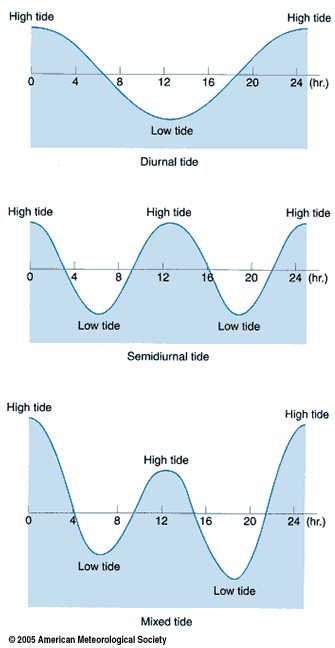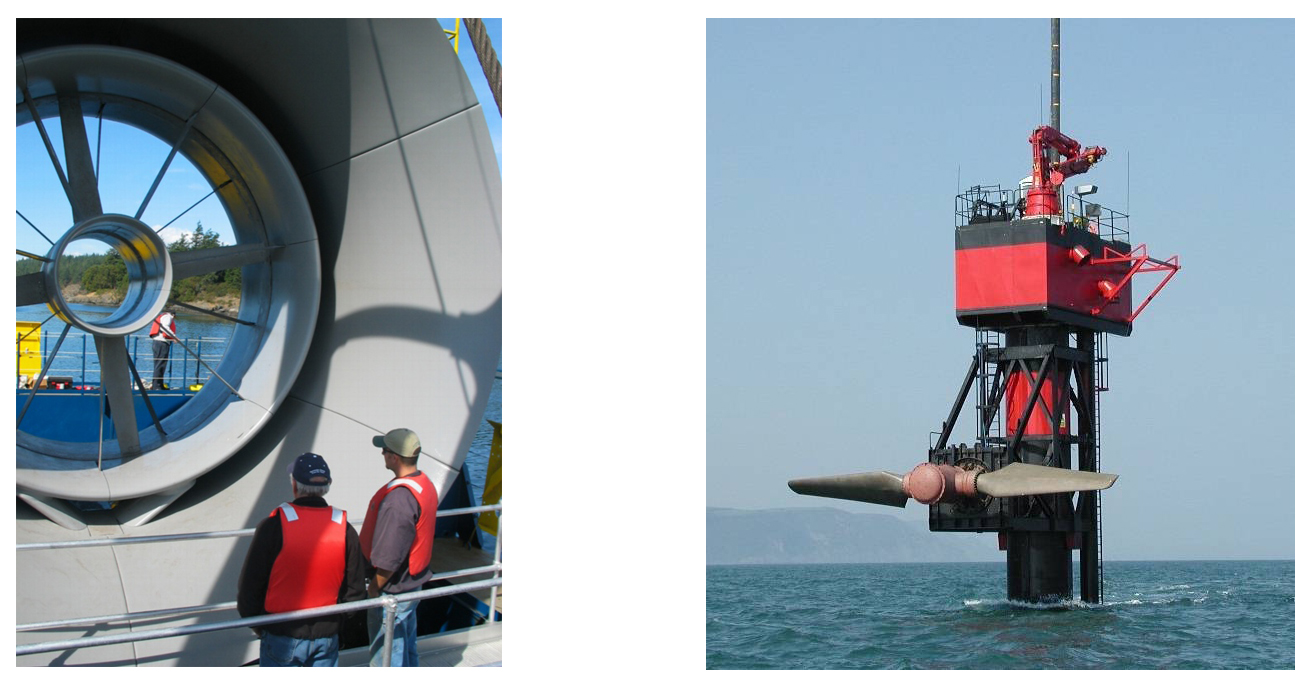There are actually many types of tides. That is what makes tidal energy so interesting. There is a sinusoidal fluctuation of the energy of waves.
The strength of tides is determined by the relationship between where the moon is relative to the Earth.
On Atlantic Coast, semi-diurnal tides occur. These consist of two high and two low tides daily with little variation. On the other side, diurnal tides consist of one high and one low tide. Mixed tides are the same as semi-diurnal tides but have greater disparity between high and low tides.
An incoming tide is a flood tide and an outgoing tide is a ebb tide. The period in between is the slack tide. We also have riptides, which are strong, subsurface currents that conflict with another current. These usually occur at areas of violent underwater activity. They are usually underwater currents and cannot be seen on the surface. On the other hand, tiderips can be seen on the surface and look like choppy water.
Pictures of types of tides:
RIPTIDE
TIDERIP
Sources:
http://oceanmotion.org/html/background/tides-types.htm
http://www.oregon.gov/DSL/SSNERR/docs/EFS/EFS02typetides.pdf
http://en.wikipedia.org/wiki/Rip_tide
Disclaimer
UCLA ESS 15 ocean/climate science communication project for Prof. Tripati in Fall 2014
Copyright Disclaimer: Pursuant to Section 107 of the Copyright Act of 1976, allowance is made for 'fair use' for purposes such as criticism, comment, news reporting, teaching, scholarship, and research. Fair use is a use permitted by copyright statute that might otherwise be infringing. Non-profit, educational or personal use tips the balance in favor of fair use.
Copyright Disclaimer: Pursuant to Section 107 of the Copyright Act of 1976, allowance is made for 'fair use' for purposes such as criticism, comment, news reporting, teaching, scholarship, and research. Fair use is a use permitted by copyright statute that might otherwise be infringing. Non-profit, educational or personal use tips the balance in favor of fair use.
Monday, December 1, 2014
Tidal Ecosystems-
After talking a bit about the effects on the environment caused by tidal power plants, I felt obligated to write a bit about the organisms that inhabit tides.
Sources:
http://en.wikipedia.org/wiki/Intertidal_ecology
http://seaworld.org/animal-info/ecosystem-infobooks/tide-pools/intertidal-ecology/
http://www.enchantedlearning.com/subjects/ocean/Intertidal.shtml
Above is a simple layout of what a tidal ecosystem looks like. There are various advantages to living in a tidal ecosystem. There is an abundance of nutrients and oxygen. Food sources are readily available and there are various places to inhabit in a tide that provide great protection and homes for aquatic creatures. There are some challenges that organisms living in tides have to deal with. They must be able to deal with decreased moisture and increased water temperature. Also, salinity constantly changes in tidal zones and organisms need to tolerate a wide range of salinity levels. Animals also have to compete for limited living space as tidal ecosystems are not extremely large areas.
One must also note that at various times, the inter tidal is exposed to the air. Many organisms have adapted to living both underwater and on land. The tidal ecology is extremely diverse and is filled with various species including crabs, urchins, shrimps, sea anemones, starfish, clams, krill, and various bivalve organisms like clams and oysters. These organisms have adapted to all the above listed challenges and help to create a sustainable food web in a dynamic ecosystem with large fluctuations.
As the organisms in tidal ecosystems are already dealing with many challenges, it can be said that tide power plants will cause increased strain on these animals and their already "stressful" lives. Therefore, we must really consider if tidal power plants are a viable solution to aid our energy concerns.
Sources:
http://en.wikipedia.org/wiki/Intertidal_ecology
http://seaworld.org/animal-info/ecosystem-infobooks/tide-pools/intertidal-ecology/
http://www.enchantedlearning.com/subjects/ocean/Intertidal.shtml
Possible Solutions to Negative Tidal Power Impacts on Marine Life
The negative impacts brought upon by the usage of tidal
waves do have possible solutions!
Many studies have been conducted on the movement of marine
life near tidal generators, and whether or not a high number of collisions
would occur between the animal and blade. For instance, a study was conducted
on a tidal stream generator in the East River in New York. 24 different motion
detectors were placed underwater to determine the movement of marine life
around the tidal generators. The results were promising, indicating that almost
no fish used the portion of the river where blades existed. Those that did use
that particular portion tended to avoid areas of imminent danger. This study
seemed to indicate that the generators were placed in a smart area, away from
heavy marine animal population; the fish that did swim around the area also
knew how to avoid potential hazards.
Problems presented by the production of the tidal generators
also have potential solutions. Experts suggested using sound insulators to keep
in the sound, as well as using devices to cancel acoustics that do get emitted.
Another possible mitigation technique would be to avoid sensitive areas at all,
and turn off production during peak marine life movement seasons. Similar
techniques were suggested to mitigate the electro-magnetic fields produced.
Devices can be implemented to contain the leakage of electro-magnetic fields,
as well as to limit the amount of field emitted in the first place. By using
non-toxic chemicals and coatings in and on the tidal power generator, the
chemical problem can be easily solved.
It is clear that there are options available to mitigate
potential problems presented by tidal power generator. Some of these have been
well researched, while there are still other studies that are under way to
determine even better ways to control these environmental impacts.
\
Sources:
http://www.energybc.ca/profiles/tidal.html
Environmental Impact of Tidal Power
Power generated from tides, in the form of tidal stream
generators and tidal barrages, are both sustainable and efficient forms of
energy production. However, they do not come without risks and impacts,
especially on the marine animals that live in the surrounding environment.
The greatest concern with the tidal stream generator is the collision
risk that it poses to surrounding organisms and animals. Because stream
generators use blades to harness the energy of the tides, animals (such as
fish) are susceptible to being struck by these fast moving blades. The risk of
blade strike is exacerbated by the high speeds of the water, which draws the
animals into, or very close to the blades.
Stream generators also produce a heavy amount of noise and
electro-magnetic fields, both of which can be highly disruptive to animals
living in the water. The noise in itself can seriously injure or kills animals
that are nearby. The electro-magnetic fields are especially harmful to animals
that rely on echolocation. Mammals such as dolphins and whales rely on
echolocation to communicate and navigate in the ocean. Because the
electro-magnetic fields are underwater, the acoustic output generated by the
tidal stream generators are even greater than they would be on land.
Additionally, the construction and operation of the tidal
stream generators also encompass the use of certain chemicals and fluids. An
accidental leakage of these fluids would be extremely harmful to the
surrounding marine animals, and could possibly have an effect much like an oil
spill. The chemical coatings on the outsides of the equipment could also erode
over time, resulting in damage to the ecosystem as well.
Despite all its positive selling points, tidal power
generators also come with many possible harmful impacts to the surrounding
marine animals. These problems could be mitigated or completely solved in the
future, but for now there still remain unanswered questions as to the true
impact of tidal power generators.
Sources:
Subscribe to:
Comments (Atom)







